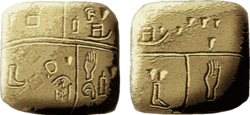Social:Kish tablet
The Kish tablet is a limestone tablet found at the site of the ancient Sumerian city of Kish in modern-day Tell al-Uhaymir, Babil Governorate, Iraq. A plaster-cast of the artifact is today in the collection of the Ashmolean Museum. The original is in the Baghdad Museum.[1] It should not be confused with the Scheil dynastic tablet, which contains part of the Sumerian king list and is also sometimes called the Kish tablet.[2]
The Kish tablet, which has not yet been deciphered, is inscribed with Proto-Cuneiform signs. It has been dated to the Uruk period (ca. 3500–3200 BC).[3] Several thousand proto-cuneiform documents dating to Uruk IV and III periods (ca. 3350–3000 BC) have been found in Uruk. It is considered the world's oldest known written document.
The writing is still purely pictographic, and represents a transitional stage between proto-writing and the emergence of the partly syllabic writing of the cuneiform script proper. The "proto-literate period" of Egypt and Mesopotamia is taken to span about 3500 to 2900 BC. The administrative texts of the Jemdet Nasr period (3100–2900 BC), found among other places at Jemdet Nasr and Tell Uqair represent a further stage in the development from Proto-Cuneiform to cuneiform, but can still not be identified with certainty as being written in Sumerian, although it is likely.[4]
See also
- Uruk period
- History of writing
- Narmer Palette
- Warka Vase
- Tărtăria tablets
- List of oldest documents
References
- ↑ FIELD, HENRY. “The Field Museum-Oxford University Expedition to Kish, Mesopotamia 1923-1929.” Anthropology Leaflet, no. 28, 1929, pp. 1–32
- ↑ Scheil, Vincent (1911). "Les plus anciennes dynasties connues de Sumer-Accad". Comptes rendus des séances de l'Académie des Inscriptions et Belles-Lettres 55 (8): 606–620. https://www.persee.fr/doc/crai_0065-0536_1911_num_55_8_72913.
- ↑ Hayes, John L., 1990 A Manual of Sumerian Grammar and Texts, Undena Publications, p.266
- ↑ Woods, Christopher (2010), "The earliest Mesopotamian writing", in Woods, Christopher, Visible language. Inventions of writing in the ancient Middle East and beyond, Oriental Institute Museum Publications, 32, Chicago: University of Chicago, pp. 33–50, ISBN 978-1-885923-76-9, http://oi.uchicago.edu/pdf/oimp32.pdf
Further reading
- A. C. Moorhouse, The Triumph of the Alphabet: A History of Writing
- Langdon, Pictographic Inscriptions from Jemdet Nasr
- Peter N. Stearns, The Encyclopedia of World History (2001), ISBN:978-0-395-65237-4.


